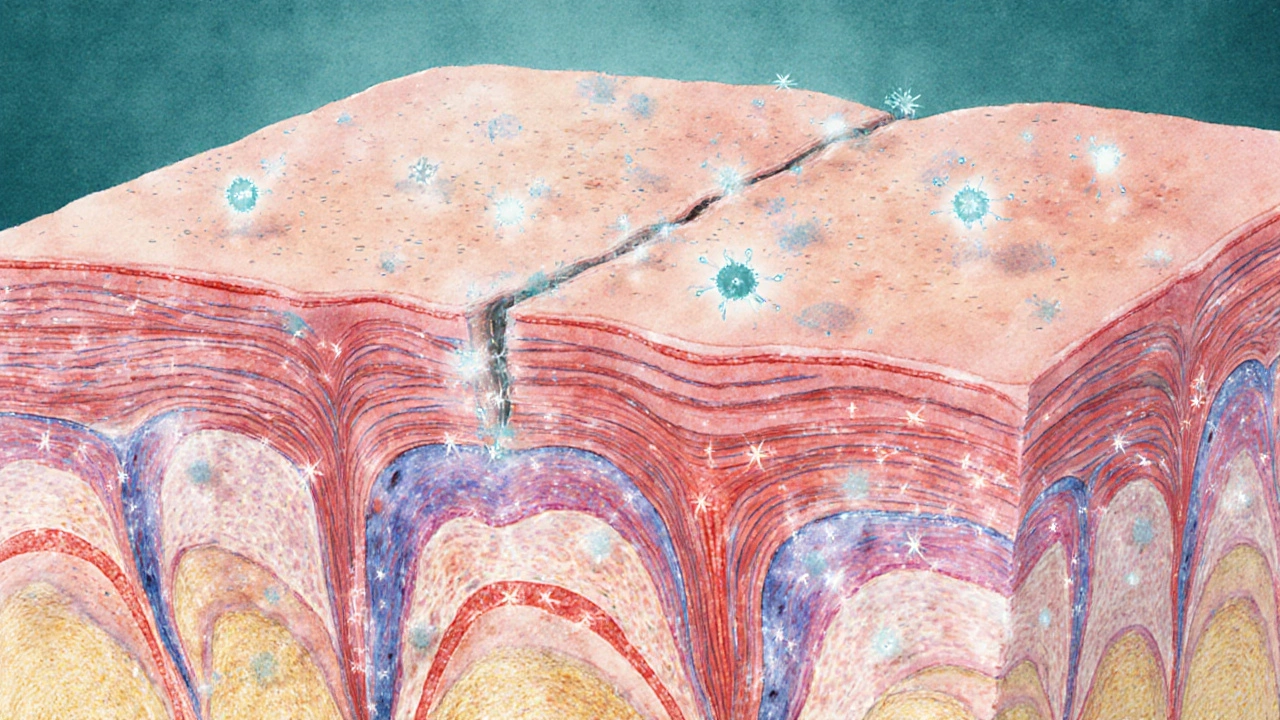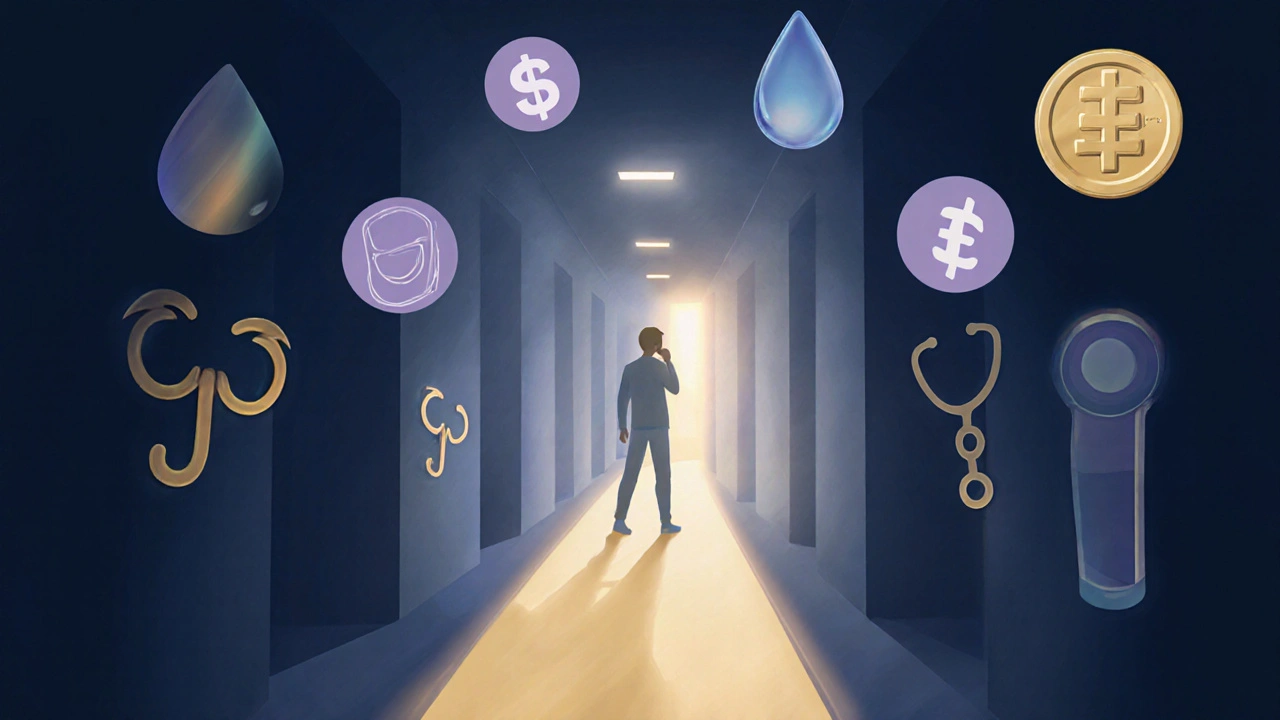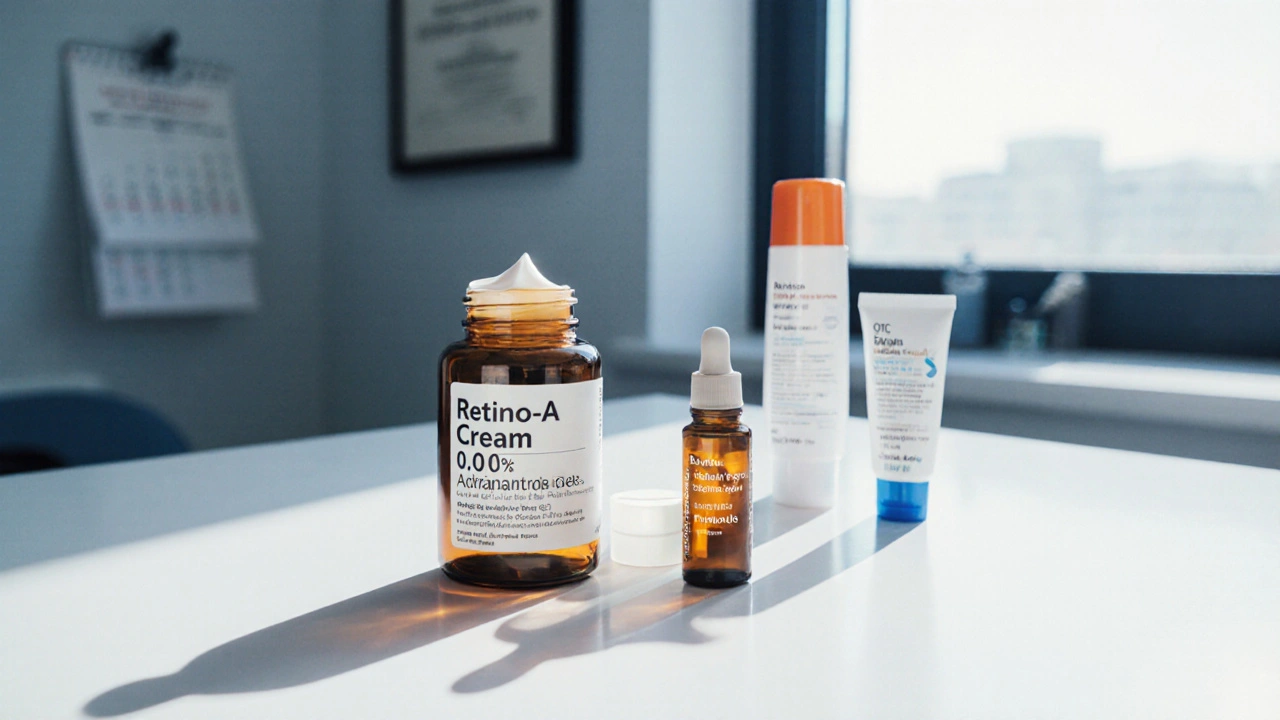Retino A Cream 0.05% vs Alternatives: Product Selector
Recommended Product
Select your preferences and click "Compare Products" to get personalized recommendations.
Product Comparison Table
| Product | Strength | Irritation Level | Prescription Needed | Price Range |
|---|---|---|---|---|
| Retino A Cream 0.05% (Tretinoin) | 0.05% | High | Yes | $30-$80 |
| Adapalene 0.1%-0.3% | 0.1%-0.3% | Moderate | No (OTC) | $15-$25 |
| Retinol 0.5%-1% | 0.5%-1% | Low-Moderate | No | $20-$60 |
| Azelaic Acid 15%-20% | 15%-20% | Low-Moderate | No | $25-$40 |
| Benzoyl Peroxide 2.5%-5% | 2.5%-5% | Moderate | No | $8-$15 |
Quick Takeaways
- Retino A Cream 0.05% is a prescription‑strength tretinoin product that delivers fast acne and anti‑aging results but can cause irritation.
- Over‑the‑counter retinoids like adapalene and retinol are gentler, cheaper, and don’t require a doctor’s note.
- Acne‑focused actives such as benzoyl peroxide and azelaic acid work through antibacterial or anti‑inflammatory pathways, offering alternatives for sensitive skin.
- Cost varies dramatically: tretinoin prescriptions often cost $30‑$80 per tube, whereas OTC options can be under $20.
- Choosing the right product hinges on skin type, tolerance, treatment goals, and whether a prescription is feasible.
If you’re weighing Retino A Cream against other options, start by understanding what makes it unique.
Retino A Cream 0.05% is a prescription‑strength formulation of tretinoin, a vitaminA‑derived retinoic acid that accelerates cell turnover and boosts collagen production. It’s typically prescribed for moderate to severe acne, sun‑damage reversal, and fine‑line reduction. The 0.05% concentration translates to 0.5mg of tretinoin per gram of cream, a level strong enough to show results within weeks but strong enough to trigger redness, peeling, and dryness for many users.
How Tretinoin Works
At the cellular level, tretinoin binds to retinoic acid receptors (RAR) in the nucleus, modulating gene expression that controls keratinocyte differentiation. This leads to:
- Faster shedding of dead skin cells, unclogging pores.
- Stimulation of fibroblasts to produce new collagen, improving texture.
- Reduction of hyperpigmentation by normalizing melanin distribution.
Because it works from inside the skin, the effect is deeper than many topical OTC actives, but the trade‑off is a higher irritation potential.

Top Over‑the‑Counter Alternatives
Below are the most common OTC or less‑prescription‑intensive alternatives, each introduced with a brief definition.
Adapalene is a synthetic retinoid (commonly 0.1% or 0.3% gels) that targets comedonal acne with a lower irritation profile than tretinoin. It was first approved for OTC use in the U.S. in 2016, making it a go‑to for beginners.
Retinol is a vitaminA precursor that converts to retinaldehyde and then to retinoic acid within the skin, delivering milder anti‑aging benefits. Concentrations range from 0.1% to 1% in serums and creams.
Azelaic Acid is a dicarboxylic acid (usually 15% or 20% creams) that offers antibacterial, anti‑keratinizing, and skin‑brightening effects, useful for both acne and rosacea.
Benzoyl Peroxide is an oxidizing agent (2.5%-10% gels) that kills Propionibacterium acnes bacteria and reduces inflammation. It’s a staple for rapid acne control but can be drying.
Glycolic Acid is an alpha‑hydroxy acid (AHA) derived from sugarcane, typically 5%-10% in exfoliating pads, that loosens surface bonds and promotes smoother skin.
Vitamin C Serum (L‑ascorbic acid, 10%-20%) provides antioxidant protection, brightens hyperpigmentation, and supports collagen synthesis.
Niacinamide is a form of vitaminB3 (typically 4%-5% creams) that reduces redness, regulates sebum, and strengthens the skin barrier.
Side‑Effect Profile Comparison
| Product | Typical Irritation Level | Common Adverse Effects | Prescription Needed? |
|---|---|---|---|
| Retino A Cream 0.05% (Tretinoin) | High | Redness, peeling, dryness, photosensitivity | Yes |
| Adapalene 0.1%-0.3% | Moderate | Mild redness, occasional scaling | No (OTC) |
| Retinol (0.5%-1%) | Low‑to‑moderate | Transient tingling, mild flaking | No |
| Azelaic Acid 15%-20% | Low‑to‑moderate | Brief burning, mild itching | No |
| Benzoyl Peroxide 2.5%-5% | Moderate | Dryness, bleaching of fabrics | No |
| Glycolic Acid 5%-10% | Low‑to‑moderate | Sensitivity, occasional redness | No |
Cost & Accessibility
Budget matters for most users. Below is a rough price range for a 30g tube or equivalent container in the U.S. market (2025 pricing). All figures are average retail prices, not insurance‑adjusted.
- Retino A Cream (prescription): $30‑$80 per tube, depending on pharmacy and insurance coverage.
- Adapalene (OTC gel): $15‑$25.
- Retinol serums: $20‑$60, varying with brand and concentration.
- Azelaic Acid cream: $25‑$40.
- Benzoyl Peroxide gel: $8‑$15.
- Glycolic Acid pads: $10‑$20 for a pack of 30.
Prescription access can add an office visit cost (often $50‑$150) and may require lab tests for isotretinoin, but it unlocks the strongest retinoid efficacy.

How to Choose the Right Option
Use this decision tree to narrow down the best product for you:
- Do you need a prescription? If you’re comfortable seeing a dermatologist and want fastest results, tretinoin is the answer.
- Is your skin sensitive or reactive? Start with adapalene or a low‑percentage retinol to gauge tolerance.
- Are you targeting acne only? Benzoyl peroxide and azelaic acid work well as monotherapies or alongside a mild retinoid.
- Do you also want brightening and antioxidant benefits? Vitamin C serum + niacinamide can complement any retinoid regimen.
- What’s your budget? OTC options generally stay under $30, while prescription tretinoin runs higher but may be covered by health plans.
Remember to patch‑test any new product for at least 48hours before full‑face application.
Practical Tips & Common Pitfalls
- Start slow. Apply a pea‑size amount every third night for the first two weeks, then gradually increase frequency.
- Moisturize before and after. A barrier‑repair cream (e.g., ceramide‑rich) reduces peeling and improves compliance.
- Never skip sunscreen. Retinoids increase UV sensitivity; use at least SPF30 broad‑spectrum daily.
- Avoid mixing strong actives. Combining tretinoin with high‑strength AHAs or benzoyl peroxide at the same time can cause severe irritation - stagger usage.
- Watch for pregnancy warnings. Tretinoin and isotretinoin are contraindicated during pregnancy; always discuss family planning with your doctor.
Frequently Asked Questions
Can I use Retino A Cream over the counter?
No. In most countries, including the U.S., Retino A Cream 0.05% contains tretinoin at a strength that requires a physician’s prescription.
How long does it take to see results with tretinoin?
Visible improvement in acne or texture usually appears after 4‑8weeks, though maximal collagen benefits can take 6‑12months of consistent use.
Is adapalene as effective as tretinoin for anti‑aging?
Adapalene is excellent for acne and offers modest anti‑aging effects, but tretinoin remains the gold standard for collagen induction and wrinkle reduction.
Can I combine a retinoid with benzoyl peroxide?
Yes, but not at the same time. Use benzoyl peroxide in the morning and a retinoid at night, or alternate nights to avoid excessive dryness.
What should I do if my skin becomes too irritated?
Cut back to applying every third night, add a richer moisturizer, and consider a lower‑strength retinoid (e.g., 0.025% tretinoin or 0.1% adapalene). If irritation persists, see a dermatologist.
By weighing efficacy, tolerance, cost, and prescription requirements, you can pick the retinoid or alternative that fits your skin goals without unnecessary side effects.
